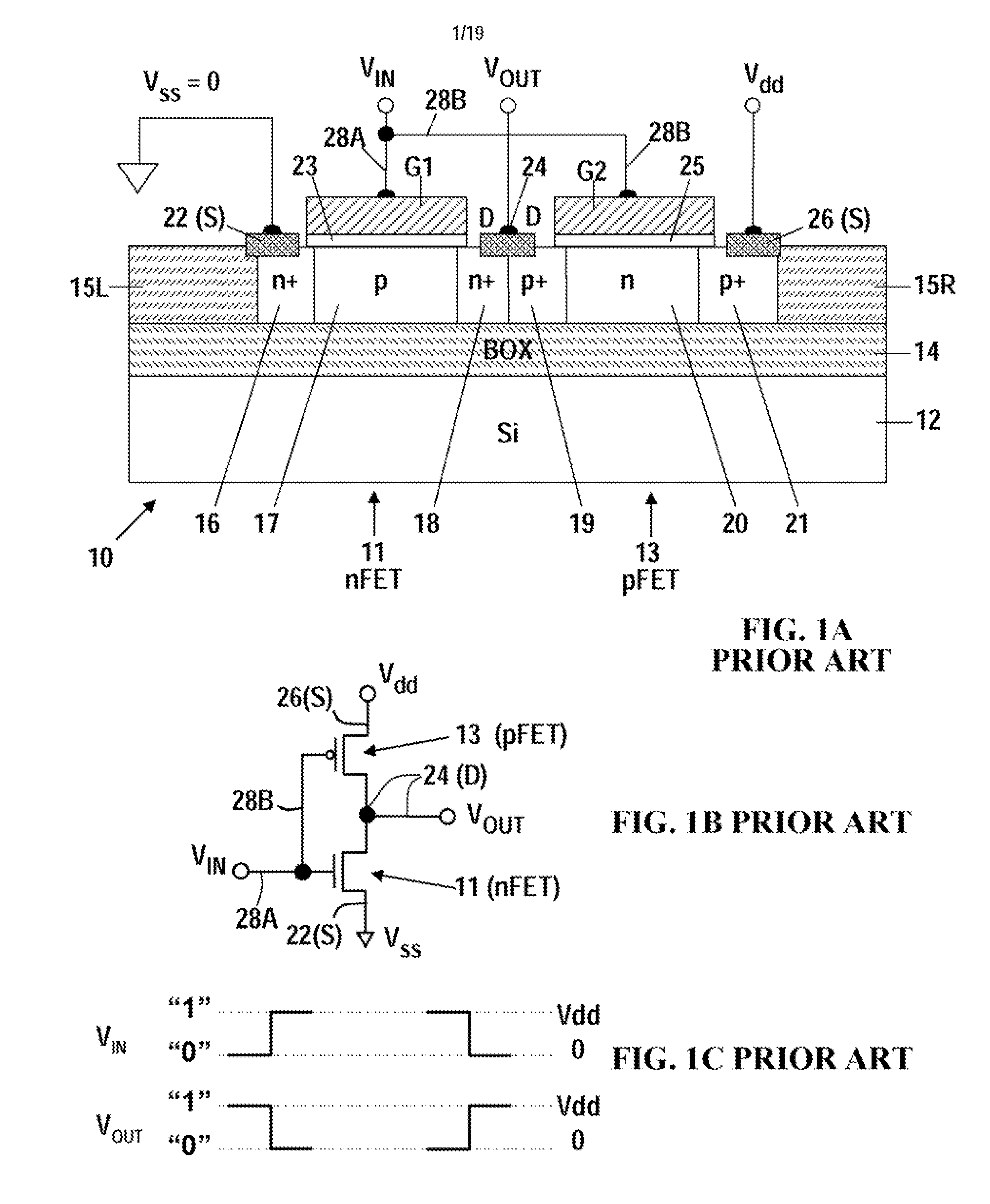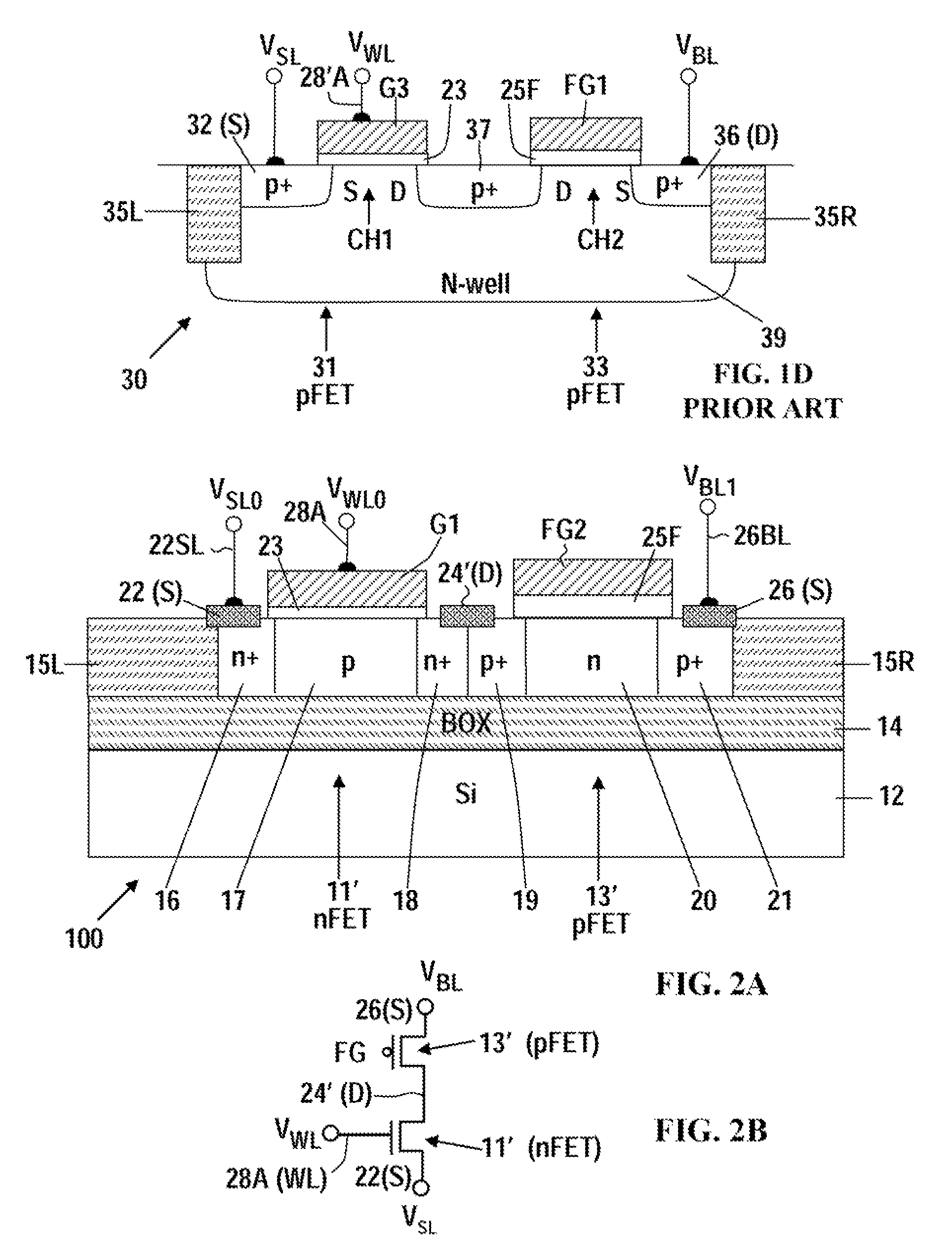CMOS eprom and eeprom devices and programmable CMOS inverters
a technology of cmos and eeprom, which is applied in the direction of semiconductor devices, instruments, electrical apparatuses, etc., can solve the problems of high density of embedded non-volatile memories, high power dissipation of floating-gate nfet memory devices, and only about half the performance of pfet select devices
- Summary
- Abstract
- Description
- Claims
- Application Information
AI Technical Summary
Benefits of technology
Problems solved by technology
Method used
Image
Examples
first embodiment
[0072]FIG. 2A is a cross-sectional, schematic view of non-volatile, EPROM cell 100 in accordance with this invention, that is a modification of the inverter 10 of FIG. 1A that includes an access nFET 11′ and a floating gate, storage pFET 13′ formed on a SOI layer on a BOX substrate. The access nFET 11′ includes a gate electrode G1 connected to a WL0 word line 28A and a source contact 22(S) connected to a SL0 select line 22SL. The storage pFET 13′ has a floating gate electrode FG2 and a source contact 26(S) connected to a BL1 bitline 26BL. A common, floating, drain contact 24′(D), that connects drain regions of the access nFET 11′ to the drain region of the floating gate, storage pFET 13′, is not connected to any external line.
[0073]For the CMOS configuration of FIG. 2A, the lowest voltage is applied to the source contact 22(S), which is the source of the access nFET device 11′. Source contact 26(S) will have the highest voltage, which is the source of the pFET device 13′.
[0074]FIG. ...
second embodiment
[0090]FIG. 4A shows an embodiment comprising a CMOS non-volatile EEPROM cell 400A in accordance with this invention, that is a modification of the EPROM cell 100 of FIG. 2A, which includes an erase device 40 and incorporates a third isolation oxide region 15C on the top surface of the BOX layer 14, is located to the right of the p+ doped source region of the storage pFET 13′. The third isolation oxide region 15C is juxtaposed with the erase device 40 which has an erase gate electrode EG that is electrically connected by an electrical conductor line 44 to the floating gate electrode FG2.
[0091]The erase device 40 can be simply one half of an FET with a second thick gate dielectric layer 27 substantially equal in thickness to the thick gate dielectric 25F of the pFET 13′. The erase device 40 includes a p doped region 41P and an n+ doped region 42 formed in the SOI layer on the top surface of the BOX layer 14. The p doped region 41P is juxtaposed with the right edge of the third isolati...
third embodiment
[0095]FIG. 4C shows a CMOS non-volatile EEPROM cell 400B in accordance with this invention, which is a modification of the EEPROM cell 400A of FIG. 4A. In FIG. 4C, the p-doped region 41P of FIG. 4A, under the erase gate electrode EG, has been replaced by an n-doped region 41N to increase the overlap of the erase gate EG with the n-type region 41N and n+ doped region 42.
PUM
 Login to View More
Login to View More Abstract
Description
Claims
Application Information
 Login to View More
Login to View More - R&D
- Intellectual Property
- Life Sciences
- Materials
- Tech Scout
- Unparalleled Data Quality
- Higher Quality Content
- 60% Fewer Hallucinations
Browse by: Latest US Patents, China's latest patents, Technical Efficacy Thesaurus, Application Domain, Technology Topic, Popular Technical Reports.
© 2025 PatSnap. All rights reserved.Legal|Privacy policy|Modern Slavery Act Transparency Statement|Sitemap|About US| Contact US: help@patsnap.com



